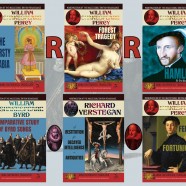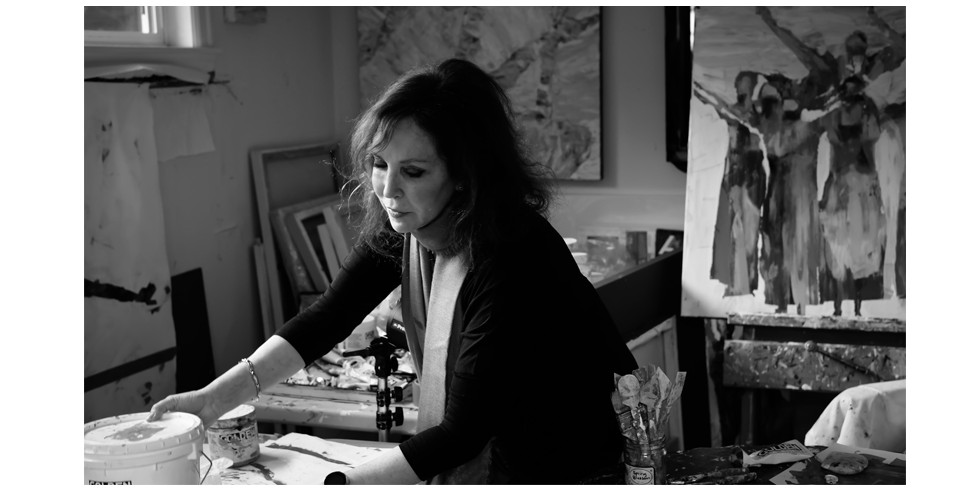
Please note this interview was Originally Published by Anna Faktorovich, Ph.D. in “Cinematic Codes Review” Anaphora Literary Press
Barbi Leifert began her studies in art at the Brooklyn Museum of Art. Then, she danced for Monmouth University, Cal State Long Beach and Skidmore College. After school she was a performance artist and contemporary dancer for an “avant garde company in downtown Soho” in NYC where she collaborated with other dancers and artists. She began writing about dance for USA Today and the Gannett newspapers and was the author of “The Manhattan Dance School Directory”, Marcel Dekker Inc, NYC. She performed with the Frank Hatchett of Broadway Dance Center, NYC and taught dance while raising her family. Her first show, at the Phillips Gallery of Fine Art, San Jose, CA, was sold out. Commissions by collectors and designers followed. Her recent solo show in NYC was “Dancer’s Palette.” Her artwork is also shown in Malibu, California, The Museum of Contemporary Art in London and various other venues in Palm Beach, Miami, Palm Springs and the Seattle area. Her paintings are in office buildings, corporate headquarters and fine residences. In the Summer of 2016, she was selected to be an artist for this year’s “Piano in the Parks” public art event in Seattle. She is also the Art Chairperson for the Tacoma Dome District, in Tacoma, WA. Her paintings have been used by ballet companies to decorate their studios and their set designs, and authors have used her artwork for book covers. She continues to work with collectors and designers, creating commissioned artworks independently and through her representatives. Her book Dancer’s Palette is available on Amazon.com. She lives Washington State. Painting in her studio and taking dance class are her daily rituals. Artist’s website: http://barbileifert.com.

“Birds of Paradise”
24″x24″
Inspired by the incomparable New York City ballet corp.
Dancer’s Palette: A Fusion of Painting and Movement: ($29.95, 54pp, Lulu, August 27, 2015): Dance is a universal language in every culture, crossing all borders; therefore, in some of the paintings in the series, I focus on the figurative of people who dance for fun. I have experimented with different ways of doing the paintings-some are more abstract than others. What started out as a series of paintings of dancers celebrating their athleticism and beauty, turned into a spiritual experience for me after I painted the fiftieth painting in the series I ‘ve always heard it said that dance is a metaphor for life, but I actually experienced it and the paintings evolved into much more than an appreciation of an aesthetic. I’m a seeker of the truth and have been since I was very young. There are many more paintings to be made in this series. It is my intent that paintings in the Dancer’s Palette series energize you and create harmony in the spaces where they live. This book is dedicated to all the dancers.
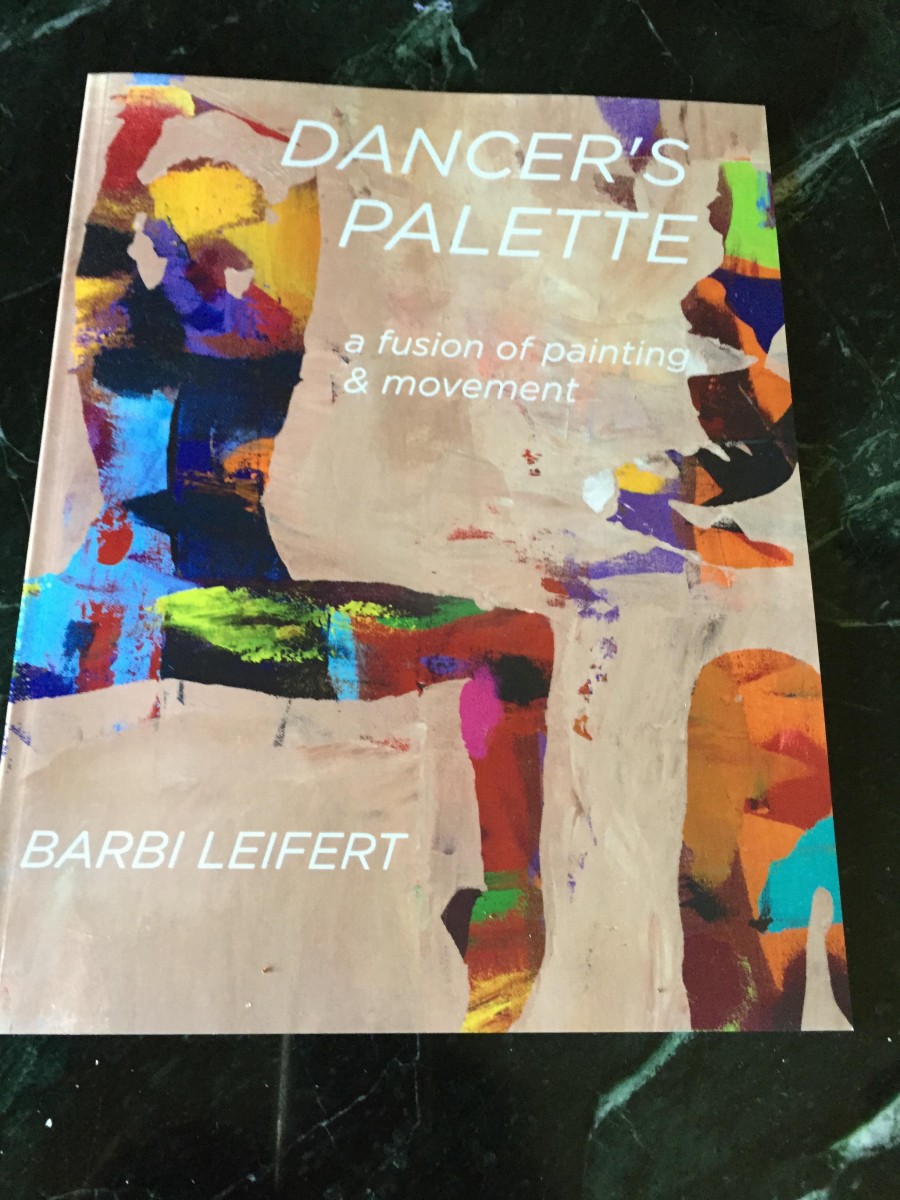
Faktorovich: You say in the description to your 2015 art book, Dancer’s Palette, that dance is a metaphor for life and goes beyond the aesthetic to the truth. Can you specify what does dance say about life? Do different positions and movements equate to movements in the plot of life (violent, still, at rest, etc.)? The term “movement” is in your subtitle. What do you tend to think about as you are drawing these?
Leifert: Dance is a metaphor for living. Dance encompasses vitality, divine energy, hope and joy. Before there was written down religion, people danced their religion. Dance is primal to human beings—it is 100,000 years old.
When I dance, I can get to a place where I am able to lose myself and I’m connected to something that can’t be described.
I began dance school lessons at age three—I continued through grade school—I was about age nine, and I remember one night my mother’s girlfriend visited. This woman was very cool. She knew I danced and she coaxed me to create an improvised dance. I’d only done that alone in my room. They played Errol Garner’s song “Misty,” sung by Johnny Mathis. I connected with the music. I felt encouraged, so I just let go. It was a breakthrough moment of losing all self-consciousness and really being one with the music. Some people call it being in the zone. I liked that place.
From that time on, I have always been a seeker of the zone. I began asking myself existential questions: who am I and why am I here—and moreover, who are you—if I’m me.
I wrote a poem about that time: I’m going to tell it to you, it will give you some insight into my thoughts. I was nine, so I used a dictionary:
The abstruse always in recluse, non-participants in life
The reckless are a parody, participants in strife
Blood shed like alizarin in this cold and hungry war
The human deaths never cease; is this what we’re living for?
So, for me dance has always been a way to go deeper into who I am and connect with my internal pulse. It sounds like new age bull until you have the actual experience of this, and most people have had that experience—whether they decide to nurture it and evolve from it is another story. I am all about evolving as a person and an artist. That is what I am here to do.
When I am painting, I don’t think. I put on music, usually Stevie Wonder, because he is so extraordinary and I lose myself in the painting, just like I did in the “Misty” dance. Time can go by without me being aware of it. I never go into the studio when I have to be somewhere in the next hour or two. I will miss the appointment.
Faktorovich: Did you use a projector to create the outlines of the dancing figures? Did you paint them on canvas or digitally? The paintings you have on your website are done in varied styles and some obviously have broken or exaggerated forms that could not have been traced from a photograph. And others like this dancer series have very realistic outlines that seem measured. Can you talk about the different paintings techniques you have experimented with, and how these worked out? Where are you currently heading with your painting? Did you use many dancers or a few of them? Are the dancers nude, or are they wearing body-hugging outfits that do not stand out in profile?
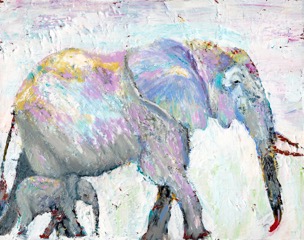
“Freedom”
30″x18″
Acrylic and mixed media on canvas
I have affinity for elephants. They should not be hunted.
Leifert: All of my work is by hand, the old fashioned way—no projections or digital and computers. The figures are painted on the canvas. I am a fan of the clean line so I use tape with the larger figures. For the murals, I create my own stencil so I can reuse the images when I’m painting murals. I spent many hours in the Atelier learning life drawing so my figures are proportional. Figures are measured as I learned to do in figure drawing class. I have many models for my paintings. I use professional dancers. The dancers are wearing body-hugging leotards when I draw or photograph them so I can see the line of the body. There is nothing more beautiful than the line of a trained dancer. That is the aesthetic I am interested in.
I paint in acrylic paint because it is easy to manipulate and is nontoxic. First, I lay down colored gesso. Some of that color will eventually peak through in the finished painting. I then organize the composition and decide what I might want the finished result to look like. I will lay down four to five more layers of color—first, warm and then cool until the figures emerge. I decide on a dominant color palette. The painting usually starts out with a plan, but I get a better result when I try not to control the outcome.
I’m in the process of formulating my next series—I’m think of ten panels: groups of people of different nationalities in each panel—doing what their groups do when they gather. I want to make a global statement.
Faktorovich: Do you think the movement to return to painting like a child, as you quote Picasso as leading in your book’s “Introduction,” is connected with the rise of photography and moving images that can achieve exact replication of a scene or a person? Does fine art fill a void that film and photography cannot fill? Can digitally edited artistic photography and film achieve this spiritual high that art has inspired in you and the world? Why or why not?
Leifert: Painting child-like is about being innocent, pure and vulnerable. To have the innocence of a child you must peel away the layers of the onion of your personality that you have built up over the years that protect you from bad things happening. This kind of painting is about feeling. It comes from within—writing, drawing, are as fundamental and primal as dance. I think photography and moving images that can exactly replicate a scene or a person are something else entirely. I also think that painting realism is fantastic—I love those mediums and they are wonderful at reflecting the world around us—even our psychology. I’m interested in something more abstract. I’m not trying to represent something as it is, but to break your perception about it. It’s more fun when there are a few paint strokes and you don’t really know what they are or why they are there. As far as achieving a spiritual high from photography and film—you can achieve a spiritual high from them, of course. It’s just not my path.
Faktorovich: I noticed that many of the movements in your dancer paintings are much more precise and stress the “signature choreographic movements” that you discuss in the “Introduction.” You seem to grab the tensest or dramatic movement in a series rather than just catching dancers in any position that they happen to be in, as Degas typically does with his ballet dancers. How did you choose these positions, and what significance do they have for you, or you hope they would have for your viewers?
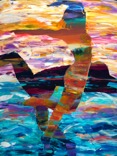
“Tumbleweed”
36″x48″
Acrylic and mixed media on canvas
Moving Mediation Series
This painting was inspired by the colors of the California desert.
Leifert: I paint the figure with ENERGY flowing through it!!! I love the climactic moment in a ballet, which is usually the “finale” when the dancers are trying to outdo each other with virtuoso moves across the stage. They demonstrate the peak of being alive. The athleticism and technical ability of dancers today is way ahead of the ballerinas Degas was painting. As technology has advanced so has the evolution of the human body and what it is capable of performing. Athletes keep breaking old records. Dancers are the finest of athletes, that’s why I paint them performing these athletic feats.
Faktorovich: I found an ad for your The Manhattan Dance School Directory book, released by Marcel Dekker Inc. from a January 8, 1979 issue of the New York Magazine on Google Books that explains that it was a collection of the possible dance schools for kids, and there is a set of black and white drawings at the bottom of the ad of dancing kids. Did you draw these adorable kids or was this the publisher? How did you do the research for this book? When I was contacting producers based on the information in the Hollywood Screenwriting Directory, I discovered that most of them were not soliciting submissions, were bankrupt and closed, or only accepted work from agented writers. Did you attempt to screen out some schools and add as many as you could or did you find most of these in a phonebook? I am curious what your process was at this early stage of your career. And how did you convince the publisher in this idea, or did he solicit your work for it? You talk about this in an interview with The Dance Enthusiast’s Sammi Lin from May 27, 2015: “New York City was called the ‘Dance Capital of the World.’ Marianne Liebert, editor of Manhattan East worked for Marcel Dekker Inc., a book publishing company. She conceived of a series of dance books and I came up with the idea of the Manhattan Dance School Directory. There were approximately 84 dance schools in Manhattan… Many of those schools closed down in the next 10 years because of the rising rents in the 1980’s.” Did your move out of NYC coincide with this change? Do you think there is another place in American today that has a similar artistic or dance climate?

“Sponge Divers, Kalymnos Greece”
36″x36″
Acrylic on canvas
This painting was interpreted from a photograph. I enjoyed abstracting seascapes.
Leifert: The dancers in the New York Magazine “Best Bets” editorial piece were drawn by an artist at New York Magazine. When I got the contract to write the dance book, I was writing for a magazine called Manhattan East—it was an upper east side weekly. The editor, this wonderful woman, Marianne Liebert, also worked for Marcel Dekker Inc, a publisher of science books. Marianne loved dance and proposed that the publisher create a dance series. Another of the books was about Dennis Wayne, whose company “Dancers” was patronized by the actress, Joanne Woodward. I pitched her the idea for “The Manhattan Dance School Directory”. At the time, there were 84 dance schools in Manhattan that taught primarily Broadway theatre dance or concert dance and ballet. I knew of most of these schools and had already taken dance class at least 20 of them. In New York during that time, these dance schools and their proprietors were legendary. Most were retired after having extraordinarily successful professional careers. New York was and still is the dance capital of the world. Now most teachers have formed larger conglomerates and teach under one roof at “Steps” or “Broadway Dance Center”—unless they are attached to a major dance company like Alvin Ailey American Dance Theatre, The New York City Ballet, American Ballet Theatre, Dance Theatre of Harlem etc. To research the book, I took dance classes at all of these schools and interviewed the dance school owners and teachers. There were some amazing studios at that time. One was “Multigravitational Aerodance” which was the precursor to Cirque de Soleil. I was literally flying and dancing at the same time. For the next 15 years, I continued to live in Manhattan and later on Woodstock, New York where my “author” credit was entrée to local newspapers in Woodstock, NY and New York City.
Faktorovich: You mentioned in your email that you worked for Gannett newspapers in Woodstock, New York for two years and then for the same chain in New York City, including USA Today. Were you working full-time as a reporter on “dance and music” in these years in your twenties, or did you write a few freelance articles? Did you have the freedom to write casually because of your husband’s job, and if so what did he do? Or were you a professional writer and supported yourself on this craft?

Leifert: I always worked as a freelance writer. I also wrote for The Woodstock Times, a very progressive newspaper in a very sophisticated arts community. I had a piece in the paper at least twice a week and once they got to know me I also covered rock and roll. It was Woodstock!!! I was sent all over the Hudson Valley to cover bands and to write either reviews or preview pieces. The Poughkeepsie Journal was my first Gannett job. I was writing a lot for them also. When I moved back to NYC after two years, I wrote for Westchester Rockland Gannett and did a few pieces for USA Today and New York Newsday. I supported myself and lived lean.
Faktorovich: Why did you decide to return to dance? You wrote, “then I started to dance again in NYC, and to teach dance. I taught at two exclusive private schools on the north shore of Long Island, and built a following, and opened a dance school of my own for three years. Then, I produced a video and did a little performing.” Were you going where the opportunities were leading you? Would you recommend for other creative people to move around between careers when they are young, or do you think you could have gone further with one of these fields if you stuck to operating your own school, teaching or one of your other experiments? And why did your school end up closing after three years? Are there pitfalls that others who are starting dance schools should avoid? Also, how did you develop a “following” in the days before the internet? Do you mean that your previous students wanted to continue studying with you, and were willing to leave the schools you were teaching in to join your venture?
Leifert: I did get married and had a son and we moved to Long Island. When my son began preschool, I wanted to work again. I’m an entrepreneur and I love creating. I started going back into NYC to take dance class, just like I had always done. I never went where opportunities led me; I always created my own opportunities. I really enjoyed teaching dance in the private schools but it was a year-long program. I taught everyone, boys, girls first grade through-12th grade. The private schools really saw the value of exposing their students to dance. I taught them basic jazz dance. This was the time when Madonna and Janet Jackson were very hot. The kids were very up for learning this. Many of them were very athletic and rode horses and participated in sports. After the year was up, many of my student wanted to continue the dance classes and I was the only one teaching this cool dance. I created a niche for myself in the community and opened a school. The students came to my studio after school. I brought out teachers from New York City to teach workshops. Michael Blevins taught for me and he was in the movie version of “A Chorus Line”. Frank Hatchett who was the Artistic Director at the Broadway dance center taught jazz and hip hop workshops. I never wanted to spend my life teaching dance in a studio. This was a way to recreate the dance studio experience I had as a young dancer.
Faktorovich: In the same email you detailed your early successes with painting: “When I was nine, my parents sent me to summer camp. I painted in oils there. I sold my first painting for $25 that summer to a parent. It was abstract with black and primary colors. That experience and acknowledgement stuck with me. I’ve sold many paintings since. (I’m experienced in sales and have been doing it most of my life).” Was your first sale an accident or did you knowingly create a mini exhibition to solicit the sale? What are the strategies you utilize to sell your art? I have recently been experimenting with posting my art on t-shirts and the like on Threadless and RedBubble, but I haven’t made any sales. I am sure there are plenty of other artists (and not just Van Gogh) that struggle with the sales end of art. What can they and I do to promote ourselves, or to find buyers willing to purchase the rainbow of possible artistic creations? Are there websites that work best for this? Do you mingle a lot to make connections and if so, at what kinds of events? Any ideas should be helpful.
Leifert: The sale of the painting in summer camp was a total shock. I did not solicit it, but it was in the same breakthrough year that I danced to “Misty” and wrote the poem, so looking back, I’m not surprised. I like selling my art, but I don’t paint just to sell it. I paint because I really love to create paintings. But I also like producing results. I think as an artist you have to wear two hats. Artist and marketing person. I took every opportunity—now I refine and only take the good opportunities where I get paid or don’t have to pay. There are a lot of people who want artists to pay money for the “opportunity.” I’m on a few of the better websites, some I was solicited by others to join, and to others I applied to join. But I don’t sell paintings from my website or any other. I make my sales by talking to people that come into my sphere. People want to feel connected to the artist and the artwork. They also want to see it in person to see the texture. That doesn’t happen on the internet. I have no formula. I’ve had mentors in the art business and have taken their advice. My first gallerist, Sherri Barnes at the Phillips Fine Art Gallery, and I became good friends. She is the one that suggested I paint the dancers. She said, “you have to become known for something specific.”
Faktorovich: In your first email, you wrote that you explore dance in part “as a meditation, the roots of religion and how it relates to harmonics and science.” Can you elaborate on this point? How is dance a meditation? One might argue that meditation is about a lack of movement, stillness, and the silence. Isn’t dance about the opposite of these? You then write, “I’m now 60 and I approach my career like a 25-year-old because, these days, people live much longer, and I never intend on retiring… Fortunately, dance is still in my life. It inspires the painting. I still practice 3-4 times per week and I have the energy and vitality. Remember, choreography also helps the mind.” First, I previously did an interview with a farmer who said he can never retire because he has no savings on which to do so. Are there any financial motivations to your decision, or do you hope to keep on going simply for the joy of creating art and dancing? I personally also hope to never retire from my passions. Secondly, when you say that you practice 3-4 times per week, for how many hours do you practice per day and what types of dance do you exercise in, and do you do some additional exercise on top of these sessions? I am sure some of my readers want some tips on how to remain vital and strong across their lives.
Leifert: Meditation doesn’t have to be performed in stillness—just consider disciplines like tai chi—often described as meditation in motion. For me, meditation is about being awake and aware which is the main tenant of meditation. When you are moving, you can be meditating and at the same time accomplishing your goals in life. The repetition of the dance warmup that we dancers do is very meditative. Each day you have to bring your awareness to it, making it feel new and inspired.
I take a jazz based ballet class twice a week and a funky jazz class two other times. For a long time, I practiced yoga, but injured my shoulder, so when that heals I will go back to Vinyassa yoga. I also walk, bike and have a strength training regimen.
I believe in exercise, but I do not over-exercise. It keeps you young in body and mind. Motion and movement have been shown to improve learning by stimulating certain types of neurotransmitters. There are studies where people have gotten on exercise bicycles given information, and they have been more successful at retaining that information because of the movement. Retirement is not appealing to me. I have always been a results producer and I am very passionate about painting and creating, challenging myself, growing and developing as a human. I would like to leave something for future generations.
Faktorovich: You also have some credits in the cinematographic arts. You were a Video Producer on “In Rehearsal,” featuring David Storey at Broadway Dance Center, in NYC, and for “Without Your Love,” featuring Los Angeles based a capella singing group M-Pact. And you were a Film Producer on “Roam the Dome,” filmed in Tacoma, WA. What did you do in these production roles? Why haven’t you explored this field more? Were you less inspired by the camera than by the canvas?
Leifert: I only produce a video when I am really passionate about the subject. David Storey was a very talented teacher of mine at the Broadway Dance Center and a great choreographer. It was just fun dancing his choreography. He wanted me to dance in the video, but I could not produce and perform at the same time. The acapella group MPACT were friends of mine. They are very talented and were performing acapella before it was as mainstream as it now is. I loved their music, particularly the song we interpreted in the video. I hired beautiful modern dancers to perform in a segment of the video and one of the dancers acted in it as the love interest of the band member. As a producer, I was responsible for getting the funding, the locations, hiring the director, hair, makeup people and dancers and for the creative concept of each of these videos.
For “Roam the Dome,” I hired the filmmakers and created the concept along with the board of Directors of the Tacoma Dome District.
Faktorovich: In the interview with The Dance Enthusiast, you mention that some of your opening night exhibits include choreographed dances that you partially design. This seems like a great way to make an art exhibit more dynamic and exciting to visit. Why did you start doing these combinations? Do you notice a larger audience when dance is involved?
Leifert: I love having dancers involved in my exhibitions. It brings the paintings to life. It adds dimension to the exhibition and provides work for these dance artists. I remember what it was like to be young and in need of work. I have an upcoming workshop I am creating for the Tacoma Art Museums’s “30 Americans” exhibition, where I will be teaching painting and I have also had the museum hire one of my dance teachers, Chris Daigre, to lead a funky jazz dance there—it adds a participation and fun! I think the museum has not seen anything like this. We are the grande finale to their exhibit and the Tacoma News Tribune is writing a piece about us.
Faktorovich: You have said that you need to be physically fit to paint giant canvases, and you have referred to your choreography as an art. Do you see dance and art as intertwined in your art because of some innate match between them? You have drawn a few people who are chubby and who are reclining casually, but you hid their outlines in abstract shapes in contrast with photographically recording the profiles of the fit bodies of the dancers. Do you enjoy watching and depicting the beauty of the human form in dance perhaps more than dancing, or do you appreciate it because it helps you and the viewer to enter a moment of idyllic movement?
Leifert: There is probably nothing I love more than dancing and watching excellent dance. It resonates with my aesthetic. I like to show that on the canvas. There are all kinds of dancers these days. They are not all thin and lithe. I have very few pieces where I uses shadow and light to paint the body of the dancer. I paint the line—the rest you are seeing into it—which is my goal. I want the viewer to interpret the interior landscape of the figure. As for the innate match between dance and art—that’s the big question I’m exploring. It’s not something you can Google. I think there is a scientific connection between color, the string theory in physics, vibration of all living things and movement. When I have the ah-hah moment that connects all of them—and have a gut level experience—my work will change. I’m still asking the question.
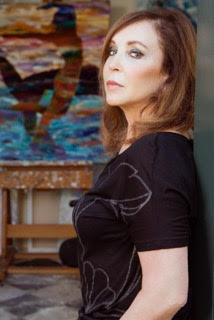
Faktorovich: If you met yourself today at the moment when you were just entering the university or your first paid dancing or art job, what advice would you give yourself? What pitfalls do you wish you avoided? What roads should have been taken? Are there words of wisdom that might have made life even better or are you content with exactly how your life has turned out? There might be young artists reading this who are at that moment and your advice might help them take the right turns.
Leifert: I would say: create written goals and actions to have those goals accomplished. Choose friends that can support those goals. Never work for someone who isn’t paying you; you are more valuable than that. Contribute your skills to charity. There isn’t one person who has the answer—seek out mentors who are not narcissistic. You are a leader and not a follower. Do not go along with “the group” thinking—learn to think for yourself and do not spout the party line you hear on television. Read the New York Times and Washington Post. Learn what is going on in the world around you. Respect all people. We are all equal.
And never give up—success will come and many good things along the way, but it all takes time.
Faktorovich: Is there anything you would like to add or anything else you would like to discuss?
Leifert: Thank you for the opportunity to express my views and share them with your audience. You are a very well researched interviewer. This has been a lot of fun.
I’m interested in bringing people together on a common ground.
Faktorovich: Thank you for doing this interview me.
Please note this interview was Originally Published by Anna Faktorovich, Ph.D. in “Cinematic Codes Review” Anaphora Literary Press









